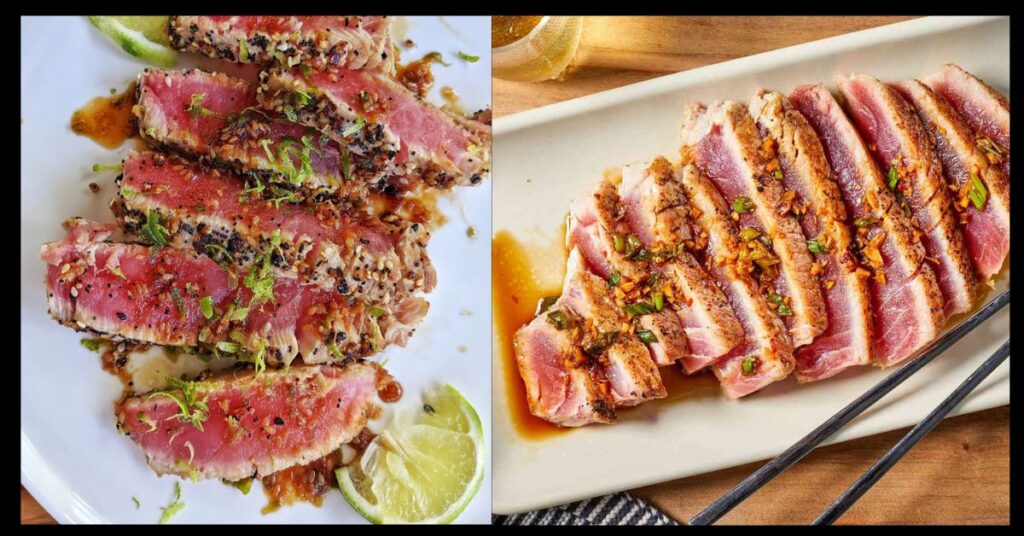Seared ahi tuna is a delicious and elegant dish that combines simplicity with bold flavors. A favorite in many high-end restaurants and sushi bars, ahi tuna is prized for its firm texture and rich, meaty flavor. This article provides a detailed guide to preparing a seared ahi tuna recipe at home, including tips for selection, preparation, seasoning, and serving. Whether for a quick weeknight meal or an impressive dinner, seared ahi tuna delivers both nutrition and sophistication.
Table of Contents
ToggleWhat Is Ahi Tuna?
Ahi tuna, also known as yellowfin tuna, is a species commonly found in tropical and subtropical oceans around the world. It is highly regarded for its mild flavor and lean flesh. The term “ahi” comes from the Hawaiian language and refers to both yellowfin and bigeye tuna.
According to the National Oceanic and Atmospheric Administration (NOAA), yellowfin tuna is considered a sustainable seafood choice when sourced responsibly, making it a popular pick among eco-conscious consumers.
Why Seared Ahi Tuna?
Seared ahi tuna is lightly cooked on the outside while remaining rare or raw on the inside. This cooking method preserves the natural flavor, texture, and nutritional benefits of the fish. Key benefits include:
- High protein content: A 3-ounce serving provides around 25 grams of protein.
- Rich in omega-3 fatty acids: Supports heart and brain health.
- Low in saturated fat: Suitable for lean eating.
The contrast between the crispy exterior and the tender center makes it a sensory delight.
Ingredients for Seared Ahi Tuna
For a classic seared ahi tuna recipe, the following ingredients are needed:
- 2 ahi tuna steaks (about 6 oz each, 1-inch thick)
- 2 tablespoons soy sauce (low sodium)
- 1 tablespoon sesame oil
- 1 tablespoon olive oil
- 1 tablespoon lemon juice or rice vinegar
- 1 tablespoon sesame seeds (white or black, or a mix)
- ½ teaspoon ground black pepper
- ½ teaspoon garlic powder
- Sea salt, to taste
- Optional garnish: sliced scallions, wasabi, pickled ginger, or microgreens
These ingredients balance umami, acidity, and texture, which are essential for enhancing the tuna’s flavor profile.
How to Select Quality Ahi Tuna
Choosing the right cut of tuna is crucial. Follow these tips:
- Sushi-grade or sashimi-grade: Indicates the fish is safe to eat raw or rare.
- Freshness: The meat should be bright red or pink with minimal odor.
- Firm texture: Tuna should be firm to the touch, not mushy.
- Source responsibly: Look for Marine Stewardship Council (MSC) certification or check with your fishmonger.
Frozen tuna can also be used if thawed properly in the refrigerator to maintain quality and safety.
Step-by-Step Instructions to Make Seared Ahi Tuna
1. Marinate the Tuna
In a small bowl, mix soy sauce, sesame oil, lemon juice, garlic powder, and black pepper. Place the tuna steaks in a resealable plastic bag or shallow dish. Pour the marinade over the fish and refrigerate for 15–30 minutes.
Tip: Avoid marinating too long, as the acidity can break down the delicate flesh.
2. Prepare the Coating
Spread sesame seeds on a plate. After marinating, remove the tuna and pat dry with paper towels. Press both sides of the tuna steaks into the sesame seeds to coat evenly.
3. Sear the Tuna
Heat a skillet or cast-iron pan over medium-high heat. Add olive oil and allow it to shimmer. Place the tuna steaks in the hot pan and sear for about 1 to 1½ minutes per side, depending on desired doneness.
- Rare: 1 minute per side
- Medium-rare: 1½ minutes per side
- Fully cooked: Not recommended, as it dries out the tuna
Do not move the fish around while searing to ensure a crisp crust forms.
4. Rest and Slice
Remove the tuna and let it rest for 2–3 minutes. Use a sharp knife to slice against the grain into ¼-inch thick slices.
Serving Suggestions
Seared ahi tuna is versatile and can be served in many ways:
- On a salad: Place atop mixed greens with a sesame-ginger vinaigrette.
- In a bowl: Serve with steamed rice, avocado, cucumber, edamame, and spicy mayo for a poke bowl experience.
- As an appetizer: Arrange slices with wasabi and pickled ginger.
- In tacos: Combine with cabbage slaw, lime crema, and warm tortillas.
A light drizzle of soy reduction or ponzu sauce enhances the umami flavor.
Tips for Perfect Seared Ahi Tuna
- Don’t overcook: Ahi tuna is best served rare to medium-rare.
- Use a non-stick or well-seasoned pan: Prevents sticking and ensures even searing.
- Dry thoroughly: Moisture interferes with searing and crust formation.
- Use high-quality oil: Choose oils with high smoke points like avocado or sesame oil.
Is Seared Ahi Tuna Safe to Eat?
Yes, seared ahi tuna is safe when proper food handling is followed. Always purchase from reputable sources and choose sushi-grade tuna. According to the U.S. Food and Drug Administration (FDA), freezing fish at -4°F (-20°C) for seven days kills parasites that might be present in raw fish.
Pregnant individuals, young children, and those with compromised immune systems should avoid raw or undercooked fish as a precaution.
Health Benefits of Ahi Tuna
Ahi tuna offers several health advantages:
- Omega-3 fatty acids: Help reduce inflammation and support cardiovascular health.
- Low calories: A 3-ounce cooked portion has approximately 120–150 calories.
- Vitamins and minerals: High in B12, niacin, selenium, and phosphorus.
However, it is advisable to limit consumption to two servings per week, as larger tuna may contain higher levels of mercury (FDA and EPA guidelines).
Conclusion
Seared ahi tuna is a flavorful, nutritious, and visually appealing dish that can be made easily at home with the right techniques and ingredients. By understanding how to properly select, prepare, and cook ahi tuna, anyone can enjoy a restaurant-quality meal in their own kitchen. Whether served as a main course, appetizer, or part of a vibrant poke bowl, seared ahi tuna is sure to impress with its bold taste and elegant presentation.







